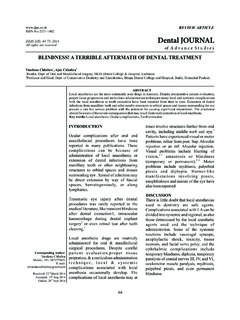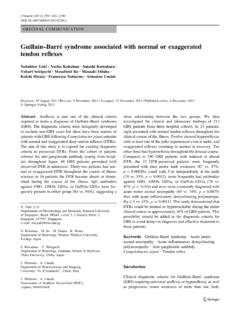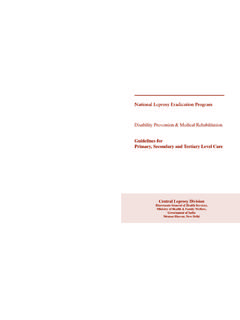Transcription of Ptosis Evaluation and Management - Best …
1 Otolaryngol Clin N Am 38 (2005) 921 946. Ptosis Evaluation and Management Brenda C. Edmonson, MD*, Allan E. Wulc, MD. 847 Easton Road, Suite 1500, Warrington, PA 18976. Drooping of the upper eyelids is one of the most common complaints in oculoplastic practice. Other related complaints include di culty seeing due to the attendant visual eld obstruction and prefrontal headaches due to chronic use of the frontalis muscle in an attempt to lift the eyelids [1]. This anatomic and morphologic state is termed Ptosis , from the Greek to fall.''. Ptosis causes a simultaneous cosmetic deformity that is apparent both to the patient and to others. A recent study suggested that photographs of patients with droopy lids are subjectively perceived by others as less intelligent and more negatively than their counterparts when compared with photographs after having undergone Ptosis correction [2].
2 Ptosis surgery can be challenging for even the most experienced eye and facial plastic surgeon. The rate of reoperation in most series of acquired Ptosis varies from 5% to 35% [3 5]. The correction of Ptosis of more complex etiology, and congenital Ptosis may even be more elusive. To minimize reoperations and maximize postoperative symmetry, detailed preoperative assessment and intraoperative anatomic dissection with respect to tissue planes and hemostasis are necessary. This article discusses some of the more common types of Ptosis and provides an introduction to the Evaluation and Management of the Ptosis patient. Complications of Ptosis surgery and recent innovations in Ptosis surgery are discussed.
3 Terminology The eyelid ssure is a measurement of the opening of the eyelid when the eye is in primary position (looking straight ahead). It is measured in millimeters at the center of the eyelid from the bottom of the upper lid to the top of the lower lid. The normal measurement is 9 to 10 mm. Ptotic eyes are de ned as those with eyelid ssures less than 9 mm. * Corresponding author. E-mail address: ( Edmonson). 0030-6665/05/$ - see front matter 2005 Elsevier Inc. All rights reserved. 922 EDMONSON & WULC. Marginal re ex distances (MRDs) are measurements that are often useful as well. MRD1 is the distance from the upper eyelid to the corneal light re ex. Measurements less than 4 mm are considered abnormal; an MRD1 of or less is usually considered vision-impairing.
4 MRD2 the distance from the corneal light re ex to the lower eyelid. A normal measurement is 4 to 5. mm; a measurement of more than 5 mm represents a lower eyelid that is too low and can be caused by eyelid retraction or ectropion. A patient can have a ptotic upper eyelid and a normal eyelid ssure if the lower eyelid position is abnormally low. All three measurements are therefore important. Levator function is a measurement of how well the levator muscle works. Normal function is greater than 11 mm. A measurement greater than 11 mm is considered very good, 8 to 10 mm is considered good, 5 to 7 mm is considered fair, and 4 mm or less is considered poor. Classi cation of Ptosis Ptosis can occur for a variety of reasons.
5 Congenital Ptosis may be diagnosed shortly after birth. Mechanical Ptosis due to dermatochalasis and brow Ptosis is often seen in the aging population and can accompany many of the other types of Ptosis . Myogenic Ptosis , aponeurotic Ptosis , neurogenic Ptosis , and neuromyogenic Ptosis (eg, ocular myasthenia) can all present in adults and present rarely in children as well [1]. The most common type of Ptosis in adults is involutional Ptosis secondary to acquired dehiscence or detachment of the levator aponeurosis from the tarsus [1,6]. Ptosis in children is most often myogenic in origin and due to levator muscle maldevelopment [1,6,7]. Myogenic Ptosis Myogenic Ptosis occurs when levator strength has diminished [1].
6 The most common myogenic Ptosis is simple congenital Ptosis , which can occur as an autosomal dominant or, more often, sporadically [7]. Simple congenital Ptosis is usually secondary to levator muscle maldevelopment. Approximately 30% of patients who have congenital Ptosis will also have ocular motility disturbances, the most common being weakness of the ipsilateral superior rectus muscle [6 8]. Congenital myogenic Ptosis is usually unilateral with no other associated facial abnormality (Fig. 1A) [7]. In acquired myogenic Ptosis , levator function is usually moderate but may be normal early on in the course [1,6]. In congenital myopathic Ptosis , lag on downgaze can be seen due to brosis of the levator, and lesser degrees of levator function are commonly seen.
7 Congenital Ptosis can also accompany craniofacial syndromes. Most common among these are blepharophimosis syndrome and Marcus Gunn jaw wink syndrome [1,6,7]. Blepharophimosis can be inherited as an autosomal dominant trait. The signs of bleharophimosis are bilateral Ptosis , Ptosis Evaluation AND Management 923. Fig. 1. (A) A 6-month-old patient showing congenital Ptosis of the right upper eyelid. (B) A. child with blepharophimosis. Note the Ptosis , epicanthal folds, and telecanthus. decreased horizontal ssure size, epicanthal folds (epicanthus inversus), telecanthus, and ectropion of the lower lateral eyelids (Fig. 1B) [7]. Marcus Gunn Jaw winking is caused by a miscommunication between the third cranial nerve that innervates the levator and the fth cranial nerve that innervates the muscles of mastication.
8 The result is a unilateral Ptosis that resolves or improves when the patient opens the mouth or moves the lower jaw in a contralateral direction (Fig. 2A, B) [7]. Other less common craniofacial syndromes associated with a congenital Ptosis are Turner's syndrome, Noonan's syndrome, Smith-Lemli-Opitz syndrome, Rubenstein-Taybi syndrome, Saethre-Chotzen syndrome, and Fig. 2. A 5-year-old patient showing Marcus Gunn syndrome. Patient with Ptosis of the right upper eyelid (A) that resolves with contraction of the ipsilateral masseter muscle (B). 924 EDMONSON & WULC. fetal trimetadione [9,10]. Because of their rarity, these syndromes are beyond the scope of this article.
9 In adults, trauma can give rise to myopathic Ptosis when the muscle itself is injured. More often, traumatic Ptosis involves injury to the aponeurosis, the third cranial nerve supplying the levator muscle, or the bones adjacent to the levator (mechanical Ptosis ) impinging on the excursion of the muscle itself, or due to orbital injury with consequent enophthalmos [1,6]. Orbital roof fractures, in particular, often give rise to Ptosis . If bony injury is suspected, the patient should be evaluated accordingly with appropriate neuroimaging studies. Edema of the eyelid after trauma can mimic Ptosis ;. therefore, the diagnosis of a true Ptosis may be delayed. Any lacerations of the eyelid involving the levator should be repaired as soon as possible unless the original injury is not found until weeks after the injury.
10 At this time it is best to wait 3 to 6 months to see if there is any improvement in the Ptosis before embarking upon surgical correction [6]. Patients may also present with myopathic Ptosis following blepharoplasty surgery. This type of traumatic Ptosis may be due to lid edema, hematoma, levator aponeurosis injury from cautery, or careless removal of the post septal fat from septal suturing, septal levator adhesions, or a blepharoplasty technique that involves supratarsal xation [11,12]. Ptosis repair may be di cult, because the anatomy of the eyelid has been disrupted from the previous surgery. Mild Ptosis may improve with time. Ptosis existing after 3.







